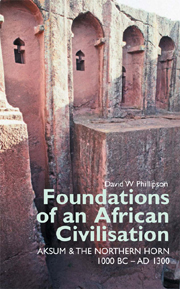Book contents
- Frontmatter
- Contents
- List of illustrations
- 1 General introduction
- Part One BEFORE AKSUM
- Part Two THE KINGDOM OF AKSUM
- 4 Aksumite civilisation: an introductory summary
- 5 Aksumite languages and literacy
- 6 Some written sources relating to Aksumite civilisation
- 7 The emergence and expansion of the Aksumite state
- 8 Aksumite kingship and politics
- 9 Aksumite religion
- 10 Cultivation and herding, food and drink
- 11 Urbanism, architecture and non-funerary monuments
- 12 Aksumite burials
- 13 Aksumite technology and material culture
- 14 Aksumite coinage
- 15 Foreign contacts of the Aksumite state
- 16 Decline and transformation of the Aksumite state
- Part Three AFTER AKSUM
- Bibliographic references
- Index
- EASTERN AFRICAN STUDIES
12 - Aksumite burials
from Part Two - THE KINGDOM OF AKSUM
Published online by Cambridge University Press: 05 December 2015
- Frontmatter
- Contents
- List of illustrations
- 1 General introduction
- Part One BEFORE AKSUM
- Part Two THE KINGDOM OF AKSUM
- 4 Aksumite civilisation: an introductory summary
- 5 Aksumite languages and literacy
- 6 Some written sources relating to Aksumite civilisation
- 7 The emergence and expansion of the Aksumite state
- 8 Aksumite kingship and politics
- 9 Aksumite religion
- 10 Cultivation and herding, food and drink
- 11 Urbanism, architecture and non-funerary monuments
- 12 Aksumite burials
- 13 Aksumite technology and material culture
- 14 Aksumite coinage
- 15 Foreign contacts of the Aksumite state
- 16 Decline and transformation of the Aksumite state
- Part Three AFTER AKSUM
- Bibliographic references
- Index
- EASTERN AFRICAN STUDIES
Summary
In the study of Aksumite civilisation, a disproportionate emphasis has been placed by archaeologists on the burials of the élite. This is not hard to explain: such interments were marked by the most impressive of Aksum's surviving monuments, and their investigation has – despite the frequency with which such prominent tombs have long ago been robbed – yielded artefacts and information of great significance. Until recently, however, the position that the élite and their monuments occupied in ancient Aksumite society was poorly contextualised, since little attention had been paid to their less prosperous contemporaries and to the basic economic underpinning of the state. The information at our disposal is almost totally archaeological.
As noted in Chapter 7, one of the earliest recognised signs of the transfer of settlement from Beta Giyorgis hill to the site of Aksum is the series of burial platforms at the foot of the southern slope of Beta Giyorgis. These platforms, now buried beneath a considerable thickness of later accumulation, grew to constitute a terrace in the area that now forms the northern half of the Stelae Park. Archaeological investigation in 1973–74 revealed traces of a series of repeatedly extended platforms with associated graves, at least some of which had been marked by stelae; there were indications that these features dated back as early as the first century AD. It was probably during the latter part of the third century that the process began of creating further tombs which – like the stelae that marked them – far exceeded in size and grandeur anything produced previously in the northern Horn.
- Type
- Chapter
- Information
- Foundations of an African CivilisationAksum and the northern Horn, 1000 BC - AD 1300, pp. 139 - 158Publisher: Boydell & BrewerPrint publication year: 2012

